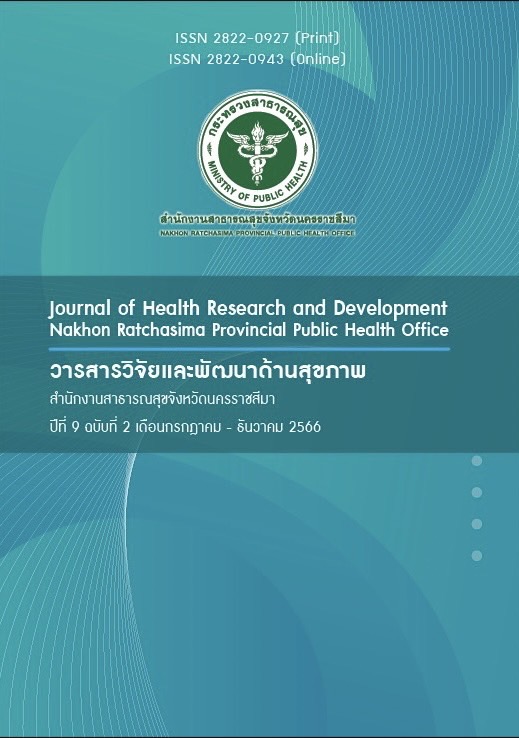The Development of Nursing Care Model for Promoting Individual and Family Self-Management of Pregnant Women with Premature labor pain in Hospital
Keywords:
Pregnant Women with Premature labor pain, Premature labor pain, Individual and Family Self-ManagementAbstract
Preterm labour affects pregnant women and their babies. Nursing care for promoting self-management helps pregnant women with premature labor pain to extend their pregnancy and reduce complications that may occur. This research and development aimed to develop a nursing care model for promoting individual and family self-management of pregnant women with premature labor pain and study the results and satisfaction after implementing the model. The samples were 20 professional nurses and 15 pregnant women with premature labor pain. Instruments used in this study were; 1) a general information questionnaire, 2) a satisfaction assessment form for pregnant women with premature labor pain in the hospital, 3) a satisfaction assessment form for professional nurses and 4) a questionnaire on self-care behaviour to prevent preterm labour. The data was collected from August to October 2023 and analysed by descriptive statistics and Pair t-test.
The findings showed that after implementing the model, the pregnant women with premature labor pain showed an increase in their average score for self-care behaviour to prevent preterm labour at a good level but statistically non-significant (p>.05). The pregnancy duration could be extended by up to two weeks. The satisfaction of these women and the satisfaction of the professional nurses on implementing the model were found to be at a good level. The study suggests midwives should use the model to care for pregnant women with premature labor pain to help them carry the pregnancy to full term.
References
World Health Organization. Preterm birth. [Online]. (2023). [cited 2023 Oct 27]. Available from: http://www.who.int/news-room/fact-sheets/detail/preterm-birth.
Ohuma E-O, Moller A-B, Bradley E, et al. National, regional, and global estimates of preterm birth in 2020, with trends from 2010: a systematic analysis. Lancet. [Online]. (2023). [cited 2023 Oct 27]. Available from: doi: 10.1016/S0140-6736 (23)00878-4
Chawanpaiboon S, Vogel JP, Moller A-B, et al. Global, regional, and national estimates of levels of preterm birth in 2014: a systematic review and modelling analysis. Lancet Glob Health. [Online]. (2019). [cited 2023 Oct 27]. Available from: doi:10.1016/S2214-109X(18)30451-0
สำนักงานสาธารณสุขจังหวัดนครราชสีมา. ร้อยละหญิงไทยคลอดก่อนกำหนดในปีงบประมาณ จังหวัดนครราชสีมา. [ออนไลน์]. (2566) [เข้าถึงเมื่อ วันที่ 27 ตุลาคม 2566]. เข้าถึงได้จาก: https:// nma.hdc.moph.go.th/hdc/reports/report.php?cat_id=1ed90bc32310b503b7ca9b32af425ae5&id=ecdbfc8b4725386c34623ce99f0f4b8d
Cunningham FG, Leveno KJ, Bloom SL, et al. Williams obstetrics. (25th). NY: McGraw Hill Education; 2018.
Gray BA. A Ticking Uterus: How Nurses Can Identify, Treat and Prevent Preterm Labor. Nurs Womens Health 2006;10(5): 380 - 9.
ศิริวรรณ แสงอินทร์. การพยาบาลมารดาที่มีภาวะเจ็บครรภ์คลอดก่อนกำหนด. [ออนไลน์]. (2557). [เข้าถึงเมื่อ วันที่ 27 ตุลาคม 2566]. เข้าถึงได้จาก: https:// he02.tcithaijo.org/index.php/Nubuu/article/view/50330/41650
Ruiz RJ, Gennaro S, O’Connor, et al. CRH as a predictor of preterm birth in minority women. Biol Res Nurs 2016; 18(3): 316 – 21.
Shah J, Baxi B. Identification of biomarkers for prediction of preterm delivery. J. Med. Soc. 2016; 30(1): 3 – 14.
Afolabi BB, Moses OE. Bacterial vaginosis and pregnancy outcome in Lagos, Nigeria. Open Forum Infect. Dis. 2016; 3(1):1 - 5.
Wagura P, Wasunna A, Laving A, et al. Prevalence and factors associated with preterm birth at kenyatta national hospital. BMC Pregnancy Childbirth 2018;18(1): 1 – 8.
ฐิติกานต์ ณ ปั่น รุ้งตวรรณ์ ช้อยจอหอ เยาวลักษณ์ เสรีเสถียร และคณะ. ปัจจัยที่มีผลต่อการเจ็บครรภ์คลอดก่อนกำหนดของหญิงตั้งครรภ์โรงพยาบาลอมก๋อย อ.อมก๋อย จ.เชียงใหม่. วารสารสาธารณสุขล้านนา 2557; 10(2): 142 – 50.
Hidayat ZZ, Ajiz EA, Krisnadi SR. Risk factors associated with preterm birth at hasansadikin general hospital in 2015. Open J Obstet Gynecol 2016; 6(13) : 798 – 807.
Lilliecreutz C, Larén J, Sydsjö G, et al. Effect of maternal stress during pregnancy on the risk for preterm birth. BMC Pregnancy Childbirth 2016; 16(1): 1–8.
Oakes MC, Chubiz J, Passafiume O, et al. First trimester stress and depression as risk factors for preterm birth: 1125. Am J Obstet Gynecol 2020; 222(1): S692 – 3.
ปิยะพร กองเงิน วิไลลักษณ์ วงศ์อาษา และกาญจนา สมบัติศิรินันท์. ผลของโปรแกรมเสริมสร้างพลังอำนาจแก่สตรีตั้งครรภ์ที่มีภาวะเสี่ยงในการคลอดก่อนกำหนดและสามีต่อพฤติกรรมส่งเสริมสุขภาพ จำนวนของการคลอดก่อนกำหนดและทารกแรกเกิดน้ำหนักน้อย. [ออนไลน์]. (2558). [เข้าถึงเมื่อ วันที่ 27 ตุลาคม 2566]. เข้าถึงได้จาก: https://he02.tci-thaijo.org/ index.php/TJONC/article/view/48694
โรงพยาบาลมหาราชนครราชสีมา. เวชสถิติหน่วยงานห้องคลอด: สถิติทารกคลอดก่อนกำหนด ปี 2560 - 2566. โรงพยาบาลมหาราชนครราชสีมา; 2566.
อัสมะ จารู, วรางคณา ชัชเวช, สุรีย์พร กฤษเจริญ. ปัจจัยทำนายพฤติกรรมการดูแลตนเองของหญิงตั้งครรภ์ที่ประสบความสำเร็จในการยับยั้งการเจ็บครรภ์คลอดก่อนกำหนด. วารสารพยาบาลสงขลานครินทร์ 2561; 39(1):79–92.
Ryan P, Sawin KJ. The Individual and Family Self-Management Theory: background and perspectives on context, process, and outcomes. Nurs Outlook 2009; 57(4): 217 – 25.
ทิพสุดา นุ้ยแม้น. ผลของโปรแกรมการเสริมสร้างพลังอำนาจต่อพฤติกรรมการป้องกันการคลอดก่อนกำหนดในหญิงตั้งครรภ์วัยรุ่นมุสลิม [วิทยานิพนธ์ปริญญาพยาบาลศาสตรมหาบัณฑิต]. สงขลา: มหาวิทยาลัยสงขลานครินทร์; 2554.
ณัฐรพี ใจงาม, อรนุช ชูศรี, รุ่งนภา ป้องกันเกียรติชัย, และคณะ. แนวคิดการจัดการภาวะสุขภาพของบุคคลและครอบครัวที่มีสมาชิกป่วยด้วยโรคเรื้อรัง. วารสารพยาบาลกระทรวงสาธารณสุข 2560; 27(3):1-9.
รัตนา พรหมบุตร จีราวรรณ พญารัง และวรรวิสา นาวาสมุทร. ประสิทธิผลของการใช้แนวปฏิบัติในการดูแลผู้บาดเจ็บ เพื่อลดภาวะเสี่ยงการตกเลือดจากการบาดเจ็บช่องท้อง. [ออนไลน์]. (2563). [เข้าถึงเมื่อ วันที่ 27 ตุลาคม 2566]. เข้าถึงได้จาก: https://he02.tci-thaijo.org/index.php/ jhri/article/view/243301
รัตนาภรณ์ ปาลีนิเวศ ธนิษฐา สุทธิ รัชนี ผิวผ่อง และคณะ. การพัฒนารูปแบบการพยาบาลเพื่อป้องกันปอดอักเสบจากการใช้เครื่องช่วยหายใจในหอผู้ป่วยวิกฤต โรงพยาบาลบุรีรัมย์. วารสารการแพทย์โรงพยาบาลศรีสะเกษ สุรินทร์ บุรีรัมย์ 2565; 37(2): 441 – 52.
สุจิตต์ แสนมงคล. การรับรู้ภาวะสุขภาพ แรงสนับสนุนทางสังคมและพฤติกรรม การดูแลตนเองของหญิงตั้งครรภ์วัยรุ่นครรภ์แรก จังหวัดภูเก็ต. วารสารวิชาการแพทย์เขต 11. 2559; 30(2):105-14.
อารีรัตน์ ชำนาญ ศิริลักษณ์ กิจศรีไพศาล และอดิศว์ ทัศณรงค. ผลของโปรแกรม การจัดการตนเองของบุคคลและครอบครัวต่อพฤติกรรมความร่วมมือในการควบคุมฟอสฟอรัสและผลคูณแคลเซียมและฟอสฟอรัสในผู้ป่วยที่ฟอกเลือดด้วยเครื่องไตเทียม. วารสารสภาการพยาบาล 2564; 36(2): 50 – 65.
อัจฉราวดี ศรียะศักดิ์ อติญาณ์ ศรเกษตริน จินตนา ทองเพชร และคณะ. การพัฒนาความรอบรู้ด้านสุขภาพเพื่อจัดการสุขภาพผู้สูงอายุที่มีภาวะเบาหวานและความดันโลหิตสูงในบริบทคลินิกหมอครอบครัว: กรณีศึกษาในจังหวัดเพชรบุรี. วารสารวิจัยระบบสาธารณสุข 2564; 15(2) : 155 – 73.
สุรีพร กัฬหะสุต พนิดา เชียงทอง สุรัชนา พงษ์ปรสุวรรณ์ และคณะ. ผลของโปรแกรมลดสิ่งก่อความเครียดร่วมกับ การสนับสนุนทางสังคม ต่อความเครียดและอายุครรภ์เมื่อคลอดของหญิงตั้งครรภ์ ที่มีภาวะเจ็บครรภ์คลอดก่อนกำหนด ที่เข้ารับการรักษาในห้องคลอด โรงพยาบาลมหาราช นครราชสีมา. วารสารศูนย์อนามัยที่ 9 : วารสารส่งเสริมสุขภาพและอนามัยสิ่งแวดล้อม 2565; 16(1): 59 – 74 .
จันทร์จีรา กลมมา ฉวี เบาทรวง และนันทพร แสนศิริพันธ์. ผลของการสนับสนุนทางสังคมต่อความเครียดของสตรีตั้งครรภ์ที่มีภาวะเจ็บครรภ์คลอดก่อนกําหนด. พยาบาลสาร 256044(3): 9 – 18.
Downloads
Published
How to Cite
Issue
Section
License
Copyright (c) 2024 Nakhon Ratchasima Provincial Health Office

This work is licensed under a Creative Commons Attribution-NonCommercial-NoDerivatives 4.0 International License.
บทความที่ได้รับการตีพิมพ์เป็นลิขสิทธิ์ของสำนักงานสาธารณสุขจังหวัดนครราชสีมา กระทรวงสาธารณสุข
ข้อความที่ปรากฏในบทความแต่ละเรื่องในวารสารวิชาการเล่มนี้เป็นความคิดเห็นส่วนตัวของผู้เขียนแต่ละท่านไม่เกี่ยวข้องกับสำนักงานสาธารณสุขจังหวัดนครราชสีมา และบุคลากรท่านอื่นๆในสำนักงานฯ แต่อย่างใด ความรับผิดชอบองค์ประกอบทั้งหมดของบทความแต่ละเรื่องเป็นของผู้เขียนแต่ละท่าน หากมีความผิดพลาดใดๆ ผู้เขียนแต่ละท่านจะรับผิดชอบบทความของตนเองแต่ผู้เดียว


